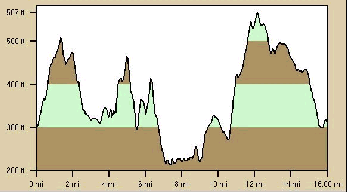Running performance is determined by the following factors and each of them can be improved to various degrees by training:
- Cardiac output (stroke volume · heart rate). Training can increase the stroke volume and slow down the decay of maximum heart rate caused by aging.
- Relevant muscles portion of weight - Type I muscles for distance runners and Type II muscles for sprinters mainly in lower limbs.
- Stride efficiency. It is widely believed that the most natural stride is the most efficient stride and it varies with people. Training can change the natural running form, or the stride to make it more efficient - less of waste of energy on movements not contributing to forward movement.
- Microscopically, the mitochondrion density of muscle cells. Mitochondria are energy factories.
- Microscopically, the myoglobin density of muscle cells. Myoglobin molecules of oxygen transportation vehicles.
- Microscopically, capillary density of muscles. Capillaries are responsible for perfusing muscle cells, or supply them with oxygen and nutrients.
- Storage capacity of glycogen in liver and muscle cells. Glycogen is the major fuel for distance running up to marathon.
Training is essentially stimulating the body to adapt to high demands (e.g. high demand of oxygen, strength, resistance to exhaustion, etc.). The stronger the stimulus, the more the body adapts. Therefore comfortable workouts are good for active recovery for maintain healthy, but they will not improve performance. Pain is necessary for progress or even for maitenance when the performance level is already vey high.

- Energy
VO2max of elite runners can be as high as 93 ml/kg/min. For most healthy young men and women, VO2max is between 45 and 55 ml/kg/min.
Assume one's O2 consumption rate during running is 50 ml/kg/min and his weight is 60 kg (132 lb), so his oxygen consumption rate is 3 liter/min.
Each liter of utilized oxygen produces about 20 kJ ( 4.8 calories), so he consumes 60 kJ (14.3 calories)/min. A bag of Power Gel has 462 kJ (110 calories) that can supply the energy consumed for 7 minutes and 42 seconds.
During running, the fat gradually becomes the major fuel. For a two-hour run, the fat contributes about 50% of the energy, the other half is from carbohydrate. One gram of carbohydrate provides 16.6 kJ ( 4.0 calories) and one gram of fat provides 37.5 kJ ( 8.9 calories). Therefore in average, he burns 1.8 g (0.064 oz) carbohydrate and 0.8 g (0.028 oz) fat per minute, or 217 g (7.6 oz) carbohydrate and 96 g (3.4 oz) of fat for the two-hour run.
Here is a good Web site about VO2max: http://www.nismat.org/physcor/max_o2.html
1 calorie = 4.2 kJ 1 oz =
28.35 g 1 lb = 453.592 g
Food:
Being an omnivore is a result of human's evolution or God's creation. There is more than enough evidence to support this. Do you know why Giant Pandas need our intervention to save them from extinguishing? If not, please find out. It will tell you more than just a biological story about Giant Pandas.
According to Ann Grandjean, Ed.D., director of the International Center for Sports Nutrition in Omaha, Nebraska, athletes who work out five or six times a week can safely increase protein consumption to as high as 1.5g per kg of body. An athlete of 60kg can consume 90g of protein per day, the equivalent of about three quarters of a pound of roast beef or 18 English muffins of 57g each.
Benefits of Distance Running:
-
Improving the quality and the capacity of cardio-pulmonary system.
-
Strengthening stamina, endurance physically and mentally.
-
Strengthening various aspects and components of lower extremities (if trained appropriately).
-
Improving concentration ability.
-
The joy of returning to and being with the nature in peace and harmony.
The benefits of running to blood hemostasis are undetermined (El-Sayed, 2000), therefore people who have high risk of stroke should be very careful about strenuous running that may increase or decrease blood clotting.
Only about a third of all people have feet of the same length. Among people who have feet fo the equal length, only about 40 percent have feet of comparable width.
Hugh Montgomery et al at University College London found the D allele of ACE (Angiotensin Converting Enzyme) is more common among top swimmers and 200-meter runners than the general population. the / allele, in contrast, is more common in 5000-meter runners. D and / alleles are two forms of the gene that encode ACE.
References:
El-Sayed MS, et al. (2000) Blood hemostasis in exercise and training. Med Sci Sports Exerc 32(5):918-25
